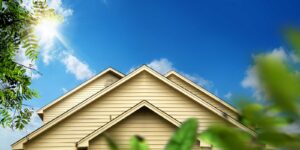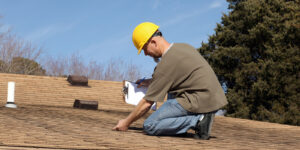Even the smallest roof leak is a major cause for concern. As soon as you see droplets of water or even water stains on ceilings and drywall, it’s a race to identify the source of the leak. But roof leaks can be tricky and can be ten or more feet horizontally away from where they appear inside your home.
If you have a roof leak in your home, it is likely coming from one of these five spots:
- Chimney
Most of the time, when a roof leak occurs, it is at a spot that is already vulnerable but protected by flashing. When the flashing or caulk fails, a leak will spring up. The flashing on chimneys is at a 90-degree angle. One side is nailed vertically to the chimney while the other is laid horizontally under the shingles. The flashing protects the space where the chimney and shingles connect, but it also needs to be sealed with caulk, which does not last as long as the flashing and shingles. If the flashing is old and cracked (or wasn’t sealed correctly in the first place) then water can seep in around it. - Vent Pipes
Vent pipes, or plumbing vents as they are sometimes called, stick out of the roof and allow air to escape from the home. Similar to chimneys, vent pipes have flashing around them. But they also have a rubber boot at the top of the vent. After years of wear, flashing will eventually crack, allowing water to get into the space between the shingles and vent pipe. Some rubber boots only last for up to seven years, so checking them regularly can help avoid a roof leak before it starts. - Skylights
Skylights are an excellent way to introduce more natural light into your home. But they are notoriously challenging for less experienced roofers to handle. If skylights are installed incorrectly, or a new roof is installed poorly around them, they will not hold up against a rainstorm. Additionally, if the weather-sealing along the edges erodes or cracks, it becomes an easy spot for water to penetrate. Most of the time, skylights will leak due to flashing problems or incorrect installation, not from the glass and joints on the actual window. - Valleys
Any place your roof intersects has a higher chance of leaking than spots where shingles can lay flat. The roof valley is the area where two planes of the roof meet. If the valley is not sealed properly, you will likely get a leak in this area. As with other materials, this barrier could also simply degrade over time, leading to a leak. - Blown-Off or Damaged Shingles
The easiest spot to identify a roof leak is one with missing shingles. You can see the shingles from the yard on most homes and will notice if a few have blown off. It is not uncommon for storms to rip shingles from the roof and create the exposed areas. Additionally, hail or falling debris like tree branches can puncture your roof during a storm, damaging shingles. As shingles are the top layer of the roof and first line of defense against moisture, a leak is inevitable when they are missing.
But one thing is sure – regardless of where your roof is leaking, the leak and water damage will only worsen if you wait. If you suspect that your roof has sprung a leak, contact a roofing specialist right away.




